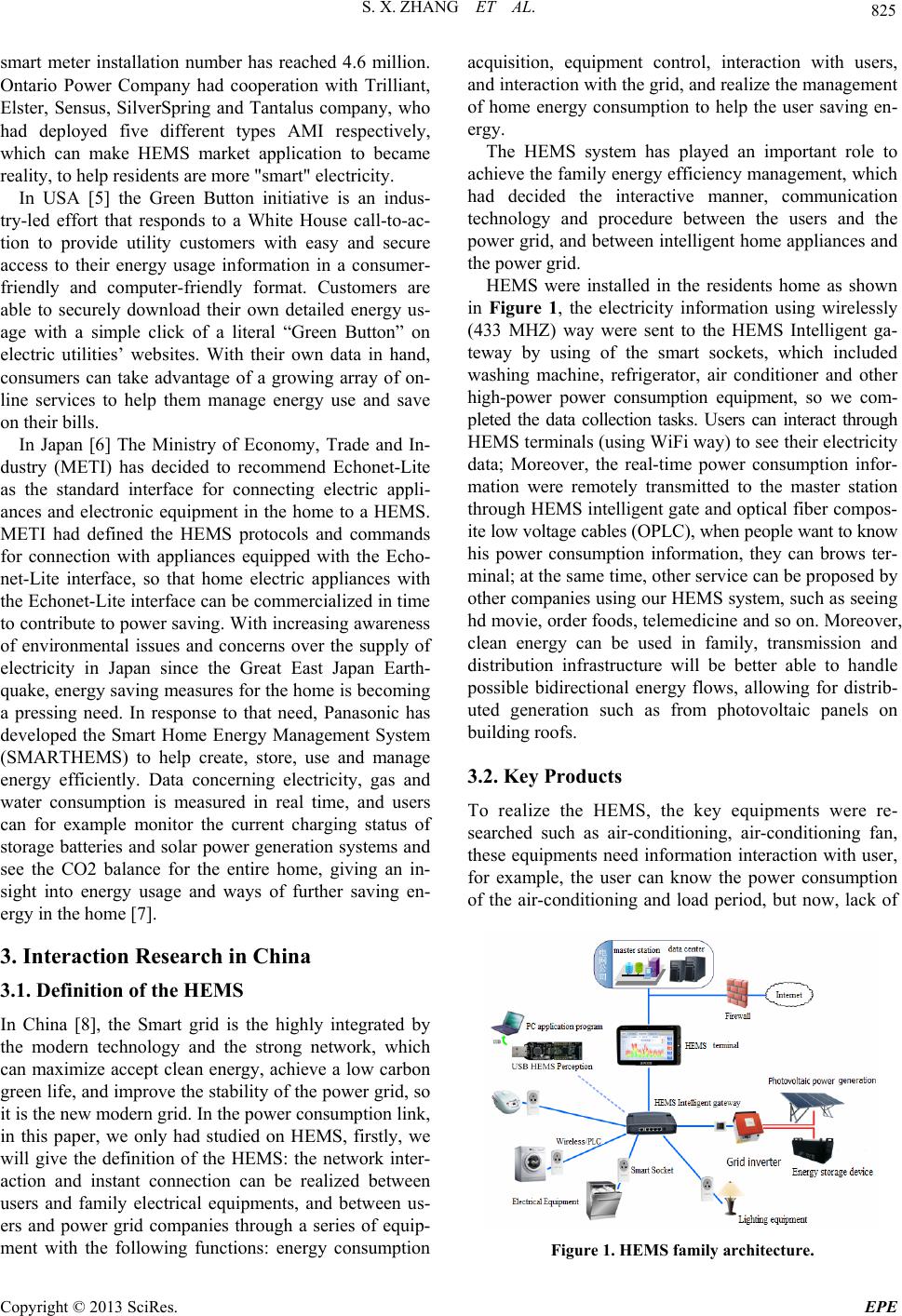
S. X. ZHANG ET AL. 825
smart meter installation number has reached 4.6 million.
Ontario Power Company had cooperation with Trilliant,
Elster, Sensus, SilverSpring and Tantalus company, who
had deployed five different types AMI respectively,
which can make HEMS market application to became
reality, to help residents are more "smart" electricity.
In USA [5] the Green Button initiative is an indus-
try-led effort that responds to a White House call-to-ac-
tion to provide utility customers with easy and secure
access to their energy usage information in a consumer-
friendly and computer-friendly format. Customers are
able to securely download their own detailed energy us-
age with a simple click of a literal “Green Button” on
electric utilities’ websites. With their own data in hand,
consumers can take advantage of a growing array of on-
line services to help them manage energy use and save
on their bills.
In Japan [6] The Ministry of Economy, Trade and In-
dustry (METI) has decided to recommend Echonet-Lite
as the standard interface for connecting electric appli-
ances and electronic equipment in the home to a HEMS.
METI had defined the HEMS protocols and commands
for connection with appliances equipped with the Echo-
net-Lite interface, so that home electric appliances with
the Echonet-Lite interface can be commercialized in time
to contribute to power saving. With in creasing awareness
of environmental issues and concerns over the supply of
electricity in Japan since the Great East Japan Earth-
quake, energy saving measures for the home is becoming
a pressing need. In response to that need, Panasonic has
developed the Smart Home Energy Management System
(SMARTHEMS) to help create, store, use and manage
energy efficiently. Data concerning electricity, gas and
water consumption is measured in real time, and users
can for example monitor the current charging status of
storage batteries and solar power generation systems and
see the CO2 balance for the entire home, giving an in-
sight into energy usage and ways of further saving en-
ergy in the home [7].
3. Interaction Research in China
3.1. Definition of the HEMS
In China [8], the Smart grid is the highly integrated by
the modern technology and the strong network, which
can maximize accept clean energy, achieve a low carbon
green life, and improv e the stability of the power grid, so
it is the new modern grid. In the power consumption link,
in this paper, we only had studied on HEMS, firstly, we
will give the definition of the HEMS: the network inter-
action and instant connection can be realized between
users and family electrical equipments, and between us-
ers and power grid companies through a series of equip-
ment with the following functions: energy consumption
acquisition, equipment control, interaction with users,
and interaction with the grid, and realize the management
of home energy consumption to help the user saving en-
ergy.
The HEMS system has played an important role to
achieve the family energy efficiency management, which
had decided the interactive manner, communication
technology and procedure between the users and the
power grid, and between intelligent h ome appliances and
the power grid.
HEMS were installed in the residents home as shown
in Figure 1, the electricity information using wirelessly
(433 MHZ) way were sent to the HEMS Intelligent ga-
teway by using of the smart sockets, which included
washing machine, refrigerator, air conditioner and other
high-power power consumption equipment, so we com-
pleted the data collection tasks. Users can interact through
HEMS terminals (using WiFi way) to see their electricity
data; Moreover, the real-time power consumption infor-
mation were remotely transmitted to the master station
through HEMS intelligent gate and optical fibe r compos-
ite low voltage cables (OPLC), when people want to know
his power consumption information, they can brows ter-
minal; at the same time, other service can be proposed by
other companies using our HEMS system, such as seeing
hd movie, order foods, telemedicine and so on. Moreover,
clean energy can be used in family, transmission and
distribution infrastructure will be better able to handle
possible bidirectional energy flows, allowing for distrib-
uted generation such as from photovoltaic panels on
building roofs.
3.2. Key Products
To realize the HEMS, the key equipments were re-
searched such as air-conditioning, air-conditioning fan,
these equipments need information interaction with user,
for example, the user can know the power consumption
of the air-conditioning and load period, but now, lack of
Figure 1. HEMS family architecture.
Copyright © 2013 SciRes. EPE